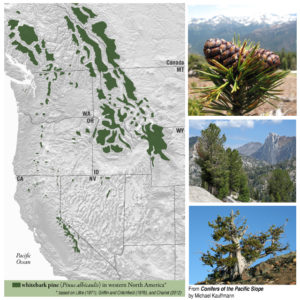Whitebark pine
Pinus albicaulis
Tree: to 70′ (shorter with increased elevation) and 8′ DBH; often multi-stemmed with upswept branches in crown, sometimes single-trunked
Bark: whitish-gray to whitish-brown, thinly furrowed blocking patterns in older trees (somewhat scaly); new growth is white; sap smells fruity
Needles: 1.5”- 3.5”, yellow-green, stiff, in bundles of 5, wrapped near the stem, some stomatal bloom on all surfaces
Seed Cones: 2”- 3”, purplish, resinous, egg-shaped to spherical and quite symmetrical, do not open on tree at maturity
Habitat: 6,000′-12,200′, subalpine, arid, exposed—only at the upper reaches of highest peaks throughout the western mountains
Observations: easily seen in the high country of Yosemite, Crater Lake, Mount Rainier, and North Cascades national parks
Remarks: decorating ridgelines, windshorn specimens are quite charismatic; most susceptible white pines to white pine blister rust, that fungi—coupled with bark beetle infestations—placed whitebark pine on the endangered species list in Canada in 2012
Information from Conifers of the Pacific Slope by Michael Kauffmann.


